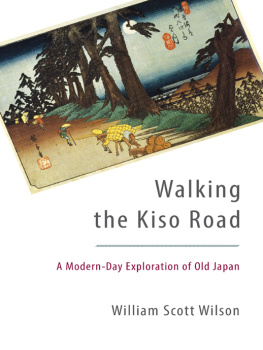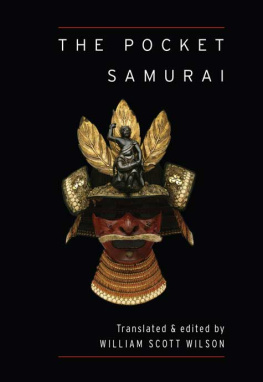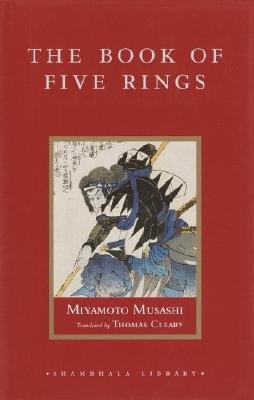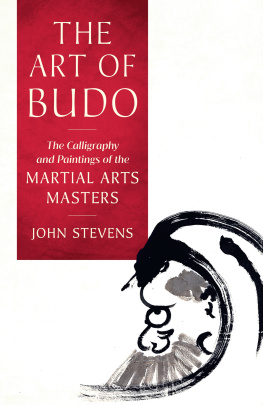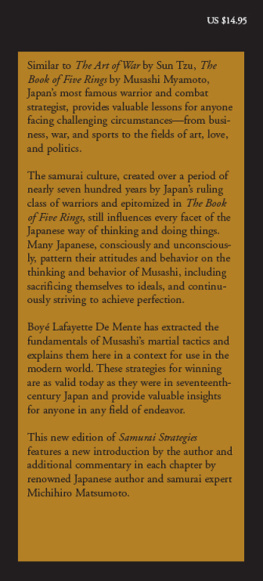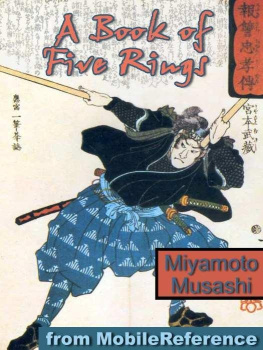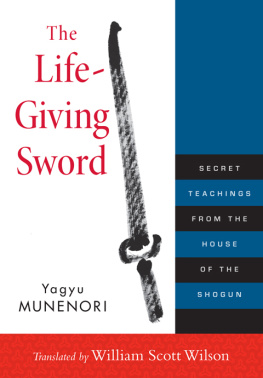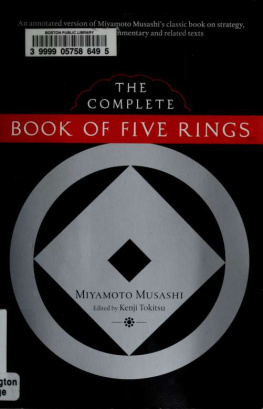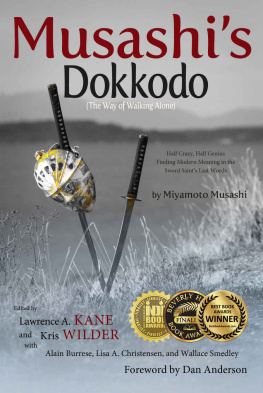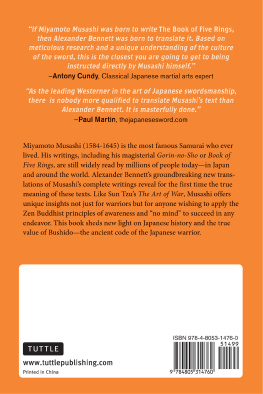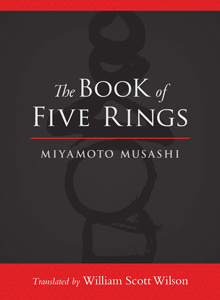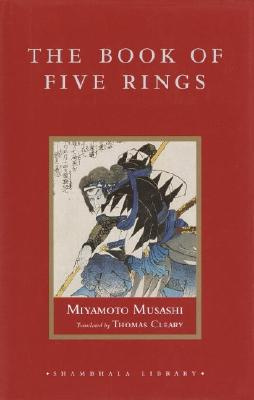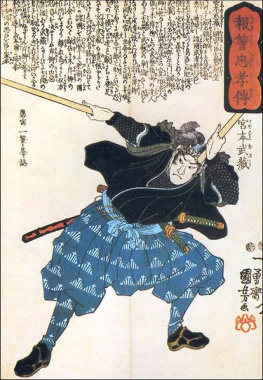ABOUT THE BOOK
Miyamoto Musashi (15841645) was the legendary samurai known throughout the world as a master swordsman, spiritual seeker, and author of the classic book on strategy, the Book of Five Rings. Over 350 years after his death, Musashi and his legacy still fascinate us and continue to inspire artists, authors, and filmmakers. Here, respected translator and expert on samurai culture William Scott Wilson has created both a vivid account of a fascinating period in feudal Japan and a portrait of the courageous, iconoclastic samurai who wrestled with philosophical and spiritual ideas that are as relevant today as they were in his time. For Musashi, the way of the martial arts was about mastery of the mind rather than simply technical prowessand it is this path to mastery that is the core teaching in his Book of Five Rings. This volume includes supplemental material on Musashis legacy as a martial arts icon, his impact on literature and film, and the influence of his Book of Five Rings.
WILLIAM SCOTT WILSON is the foremost translator into English of traditional Japanese texts on samurai culture. He received BA degrees from Dartmouth College and the Monterey Institute of Foreign Studies, and an MA in Japanese literary studies from the University of Washington. His best-selling books include The Book of Five Rings, The Unfettered Mind, and The Lone Samurai, a biography of Miyamoto Musashi.
Sign up to learn more about our books and receive special offers from Shambhala Publications.

Or visit us online to sign up at shambhala.com/eshambhala.
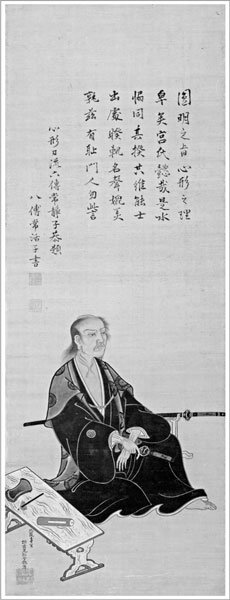
THE LONE SAMURAI
The Life of Miyamoto Musashi
William Scott Wilson

Shambhala
Boston & London
2013

To
James Craig Brems

Frontispiece: Portrait of Miyamoto Musashi by Ogata Tanko (18121868).
Reproduced by permission of the Okayama Prefectural Museum of Art.
Shambhala Publications, Inc.
Horticultural Hall
300 Massachusetts Avenue
Boston, Massachusetts 02115
www.shambhala.com
2004 by William Scott Wilson
Cover art: Miyamoto Musashi by Utagawa Kuniyoshi (17971861).
Photograph 2013, Museum of Fine Arts, Boston.
All rights reserved. No part of this book may be reproduced in any form or by any means, electronic or mechanical, including photocopying, recording, or by any information storage and retrieval system, without permission in writing from the publisher.
Library of Congress Cataloging-in-Publication Data
Wilson, William Scott, 1944
The Lone Samurai: The Life of Miyamoto Musashi / William Scott Wilson.
pages cm
Originally published: 2004.
Includes bibliographical references.
eISBN 978-0-8348-2851-3
ISBN 978-1-59030-987-2 (pbk.: alk. paper)
1. Miyamoto, Musashi, 15841645. 2. SwordsmenJapanBiography.
I. Title.
DS872.M53W55 2013
952'.025092dc23
2012037889
CONTENTS
CHAPTER
ONE

CHAPTER
TWO

CHAPTER
THREE

CHAPTER
FOUR


Terms  Historical
Historical  Figures
Figures  Clans
Clans  Events
Events  Fighting Styles
Fighting Styles  Writings
Writings  Others
Others
PUBLISHERS NOTE
This book contains Chinese and Japanese characters. If you encounter difficulty displaying these characters, please set your e-reader to publisher defaults (if available) or to an alternate font.
I first became involved in the life and work of Miyamoto Musashi a number of years ago while working on a translation of The Book of Five Rings. This was a wonderful opportunity, in part because, from my own perspective, there are few finer ways of getting to know someone than translating what he has written; in part because that short work of Musashis distills his insights on strategy, Zen Buddhism, and how to live; and in part because, for those who read closely and with a little imagination, the book stands as a record of the sixty-some duels the swordsman fought between the ages of thirteen and twenty-nine. The project turned out to be an intensive course on the very core of what might be called the Musashi myth, and on how that myth came to be.
Soon after this translation was completed, it was suggested that I might write a short volume on Musashis life and work. This also seemed a great opportunity, providing me with a chance to dig more into the details of Musashis life and to get a better idea not only of what had motivated him, but also of what has inspired the fascination with which he continues to be regarded. There seemed to be something more to this mans life than a unique sword style and excellent artwork.
As it turned out, the biography took much longer to complete than the translation, and involved far more research. Musashi, as is well known, left us only a few sentences about his own life, but other original sources are legion. These sources ranged from the Kokura Hibun, a monument inscribed with the story of Musashis life and erected by his adopted son Iori in 1654, to the Nitenki, a compilation of stories about Musashi and his disciples published in 1755 through the research of Toyoda Matashiro and his son and grandson; and a Musashi chronology, the Miyamoto Musashi monogatari nenpyo, published in 1910. Scattered among these are the records of various clans that were touched by Musashis presence, such as the Yoshioka-den, compilations of warriors deeds like the Busho kanjoki of 1716, and even family records that mentioned Musashi, such as the Numata keki. Because of discrepancies in time and place and the personal alliances of the various authors, these sources often had Musashi in different places at the same time, held various and even diametrically opposed opinions on his personality, talents, and accomplishments, and could be quite perplexing in regard to chronology: one, for example, had his father Munisai dying years before Musashi was born.
The following account is the result of sifting through this multitudinous and inconsistent material over and over again, looking for the single, consistent life within. The entire book represents my effort to answer the question, who was Miyamoto Musashi? Or perhaps the question should be framed as, who is Miyamoto Musashi, since the life of this great swordsman/philosopher/artist has never come to a full stop, but instead has been continually rewritten and expanded.
Next page

